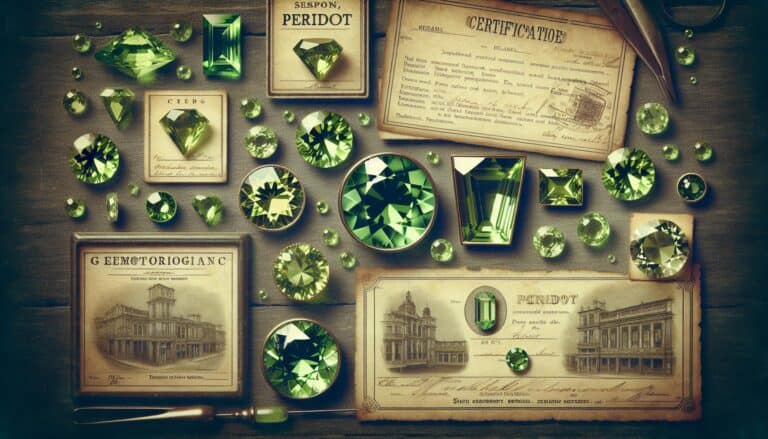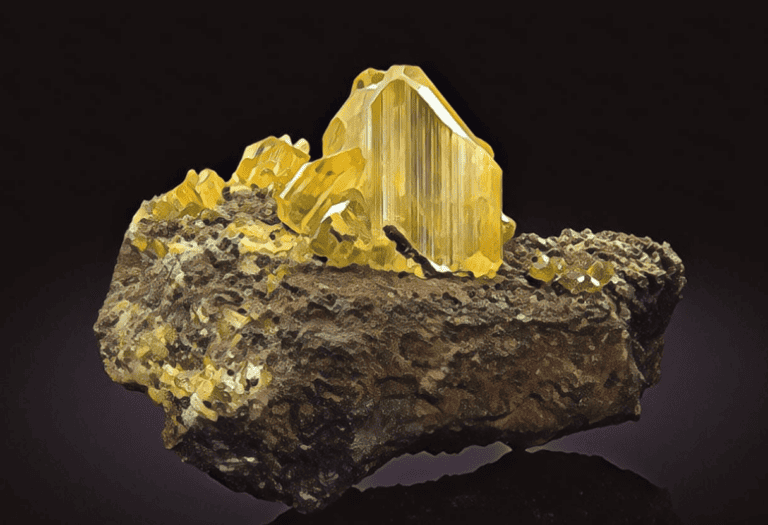Discovering the golden allure of citrine is like unearthing a piece of sunshine. You’re drawn to its warm hue, but how can you be sure it’s the real deal?
Identifying genuine citrine is crucial, as it’s often mistaken for other stones.
Sunny hue, translucent gleam, that’s the real citrine dream. No streak, scratch glass with ease, single light path finds its peace. Volcanic whispers, not magnetic, warm yellow whispers.
How to Identify Citrine Through Testing
Visual Inspection
Start by carefully examining the citrine’s color and clarity. Genuine citrine boasts a warm yellow to reddish-orange hue. Take note of any color zoning that may appear as bands of darker and lighter shades. Inclusions, common in natural stones, can often be seen with a jeweler’s loupe.
The Streak Test
Scratch the stone against a white unglazed ceramic tile; genuine citrine leaves no streak. If you notice a noticeable color, it might indicate a different mineral.
Magnet Test
Citrine does not have magnetic properties. Pass a strong magnet over the stone. A lack of reaction strengthens the likelihood that you’re dealing with real citrine.
Hardness Test
Employ the Mohs scale of mineral hardness. Citrine, being a variety of quartz, should scratch glass effortlessly, indicating a hardness level of 7.
Birefringence Test
Use a polariscope to check citrine’s birefringence, the measurement of its optical refractivity. Rotate the stone. If the light and dark areas switch, it’s a sign of birefringence, demonstrating quartz’s nature.
Checking The Diaphaneity
Hold the stone up to a light source. Citrine should transmit light evenly, exhibiting transparency or translucency depending on the stone’s quality.
Single or Double Refraction
Citrine is a single refractive gemstone meaning the light path remains constant as it passes through. Double refraction, seen in some other gems, causes a doubling of the back facets when looking through the front of the stone.
Refractive Index Test
Using a refractometer measure the refractive index (RI) of the citrine. Authentic citrine has an RI between 1.54 and 1.55 consistent with that of quartz.
Finding The Specific Gravity
Weigh the citrine in air and then suspended in water. Calculate the specific gravity (SG) by dividing the air weight by the loss of weight in water. For citrine, the SG should be around 2.65.
Identifying Citrines in the Field
In their raw form citrines are often found within quartz veins. Look for the distinctive yellow to reddish-orange color in rock cavities. A hand lens can be useful for spotting telltale signs of citrine.
Recognizing Potential Citrine Rocks
Be aware of local geology. Citrine commonly occurs in igneous rocks like granite and can also be found in alluvial deposits. Check areas where gold has been located, as quartz, and therefore citrine, may be present.
Physical Characteristics of Citrines

Understanding the physical characteristics of citrines is crucial when you’re on the hunt for genuine stones. Citrines boast a range of yellow to reddish-brown hues, a unique aspect that aids in identification. As a variety of quartz, their coloring comes from trace amounts of iron. The deeper the color, the more valued the citrine typically is.
Citrines hold a hardness rating of 7 on the Mohs scale, meaning they possess excellent durability against scratches and daily wear. This characteristic makes them ideal for jewelry that endures regular use. They exhibit a glassy luster when polished, further contributing to their allure.
Finding stones with natural imperfections such as rutilations or a mix of colors can be indicative of a genuine citrine. Moreover, natural citrines rarely display a pure, saturated color; they are often characterized by more subtle, warm tones.
- Color: Yellow to reddish-brown
- Hardness: 7 on the Mohs scale
- Luster: Glassy
It’s also important to consider the stone’s cut when identifying genuine citrine. Quality cutting maximizes the stone’s natural brilliance and ensures light is evenly reflected throughout the crystal. Remember that natural citrines are found in quartz veins and may exhibit tell-tale signs of their geological formation. Keep an eye out for these physical characteristics as they will guide you towards authentic citrine specimens.
How Are Citrine Formed?
Citrine is a gemstone steeped in geological fascination. Understanding its formation helps you make educated guesses about its authenticity. A form of quartz, citrine is born from amethyst or smoky quartz when subjected to intense heat. Typically, the temperatures range from 300 to 400 degrees Celsius. This can occur naturally within the earth or can be man-induced in a process known as heat treatment.
Natural citrines form deep in the earth where conditions are just right. Volcanic activity often plays a key role, providing the necessary heat to transform amethyst into the golden hues of citrine. Over millions of years, the high temperatures coupled with the presence of iron impurities result in citrine’s warm tone.
The stone’s birth is a slow journey, with minerals deposited in rock cavities and veins by hydrothermal fluids. These fluids, rich in silica, are essential in the growth of quartz crystals. When the fluid cools down, citrine crystals start to develop. They tend to form in the geothermal regions that are also known for producing gold, giving credence to the age-old adage of seeking citrine where gold has been found.
In short, the geological process of citrine formation is a tale of transformation under heat and pressure, a dance of natural elements that culminate in the creation of this beloved gem. When you’re hunting for authentic citrine, remember that its history is as rich as its color, and each stone carries a narrative of the earth’s fiery inner works.
Preparation for Citrine Hunting
Before you set out on your journey to discover genuine citrine, it’s crucial to be well-prepared. Gathering the right tools and considering safety are key steps that’ll enhance your chances of success and make your experience enjoyable and secure.
Gathering the Right Tools
To kickstart your citrine hunting adventure, you’ll need a specific set of tools designed for efficient and effective gemstone identification:
- Magnifying Glass: Spot subtle inclusions and fine details.
- Hardness Testing Kit: Determine if the mineral you’ve found is indeed citrine by using a testing kit based on the Mohs scale.
- Ceramic Tile: Perform a streak test to add another verification layer to your identification process.
- Magnet: Quickly rule out stones with magnetic properties that aren’t characteristic of citrine.
- Polariscope: Confirm the presence of birefringence to differentiate citrine from other minerals.
- Digital Scale and Water Container: Necessary for calculating the specific gravity of your potential citrine find.
- Geologist’s Hammer and Chisel: Extract specimens from rock formations without causing damage.
Ensuring that your toolkit is complete before you begin will save you time and boost your chances of finding that prized citrine.
Safety Considerations
While the thrill of hunting citrine can be quite absorbing, don’t forget that your safety is paramount. Here are some safety tips to follow:
- Protective Gear: Always wear safety goggles and gloves when handling tools or extracting stones to minimize the risk of injury.
- Sturdy Footwear: Equip yourself with boots that provide good ankle support and slip-resistant soles for those rocky terrains.
- Navigational Tools: Carry a reliable GPS device or map to avoid getting lost, especially in remote locations.
- Stay Hydrated and Nourished: Bring adequate water and snacks as hunts can extend over several hours.
- First Aid Kit: In case of minor injuries, having a first aid kit on hand is crucial.
- Inform Someone: Let someone know about your plans and expected return time for added safety.
By prioritizing preparation, you’re setting the stage for a successful and safe citrine hunting expedition. With the right tools in hand and safety measures in place, you’re well on your way to uncovering the hidden treasures of the earth. Remember, it’s not just about the end goal but also about the exciting experience of the hunt itself.
Handling and Care of Found Citrines

Once you’ve successfully identified and collected citrine specimens, it’s crucial to understand the proper handling and care techniques to maintain their natural luster and value. Here’s a detailed breakdown.
Cleaning Citrines
To keep your citrines sparkling, you’ll need to clean them periodically. Start with a Soft Brush and lukewarm water to gently scrub away any dirt or debris lodged on the crystal. For a deeper clean:
- Prepare a solution of mild detergent and warm water.
- Soak the citrine for several minutes.
- Rinse thoroughly with clean water.
- Dry with a soft, lint-free cloth to prevent water spots.
Avoid harsh chemicals and ultrasonic cleaners; citrines can be sensitive to strong cleaning agents and sudden temperature changes.
Storing Citrines
Proper storage of your citrine is essential to prevent scratches and damage. Wrap each stone individually in a Soft Cloth or place it inside a fabric-lined jewelry box. Consider the following tips:
- Avoid Direct Sunlight: Prolonged exposure can cause the color of your citrine to fade.
- Maintain a Stable Temperature: Fluctuations can result in fractures.
- Keep away from other harder gemstones that might scratch your citrine.
By implementing these care methods, your citrine gems will retain their dazzling beauty for years to come. Don’t overlook the need to inspect your citrines regularly for any signs of wear or damage, addressing issues promptly to ensure they remain in pristine condition.
Conclusion: Confirming Citrine is Real
Armed with the right knowledge and tools, you’re now ready to confidently identify genuine citrine.
Remember, the key to confirming your find lies in careful observation and testing. Look for those warm tones and subtle imperfections that hint at a citrine’s natural beauty. Keep your toolkit handy and prioritize safety as you hunt for these golden treasures. Once you’ve made your discovery, maintain its luster with gentle cleaning and proper storage. Stay vigilant for any signs of wear and take immediate action to preserve your citrine’s sparkle. With these tips in mind, you’re well on your way to becoming a savvy citrine spotter.
Happy hunting!







